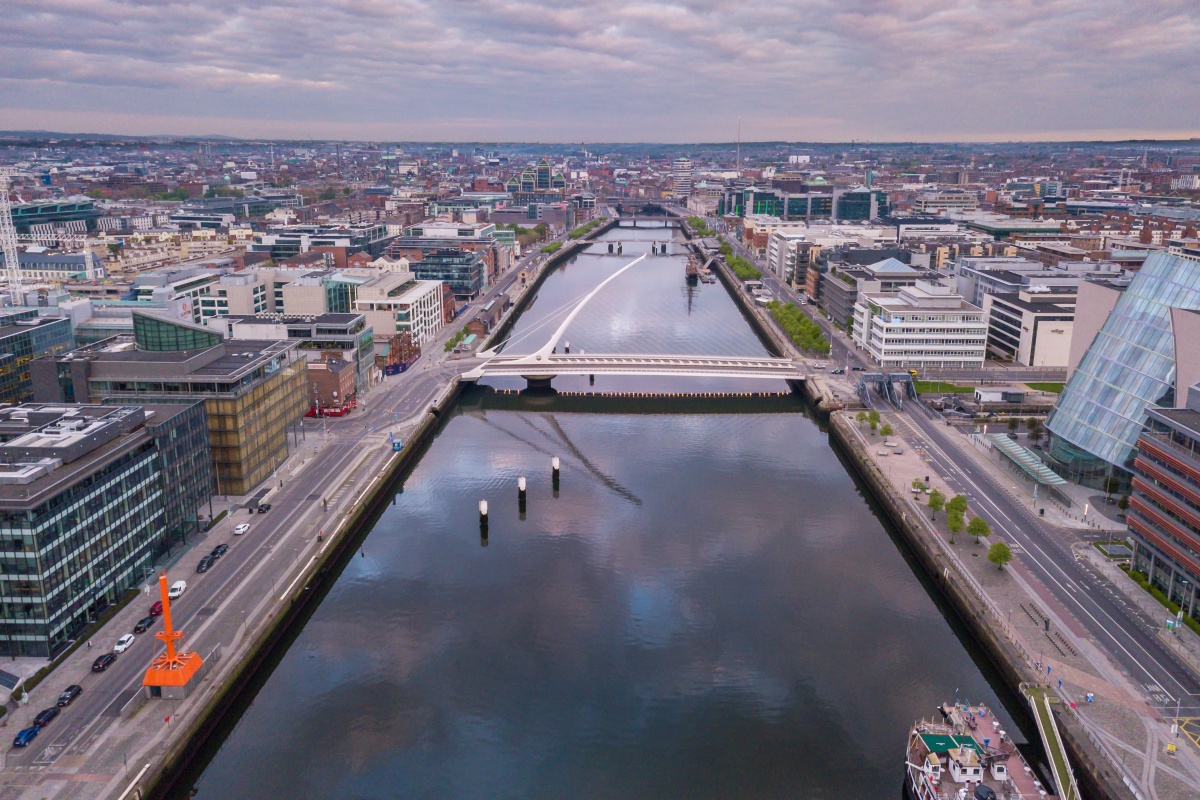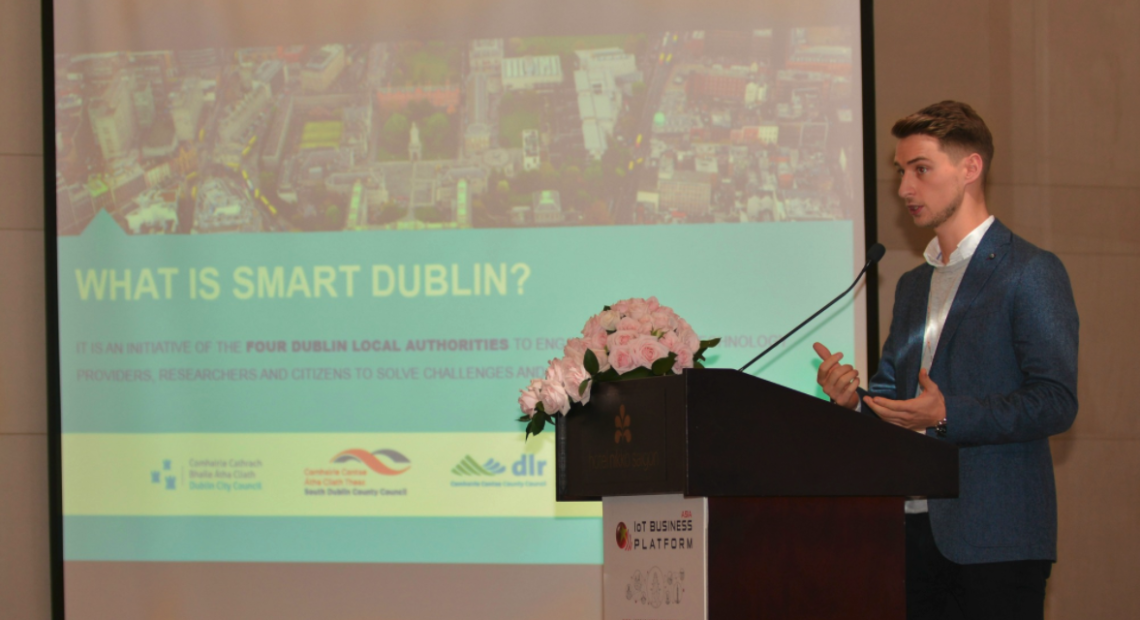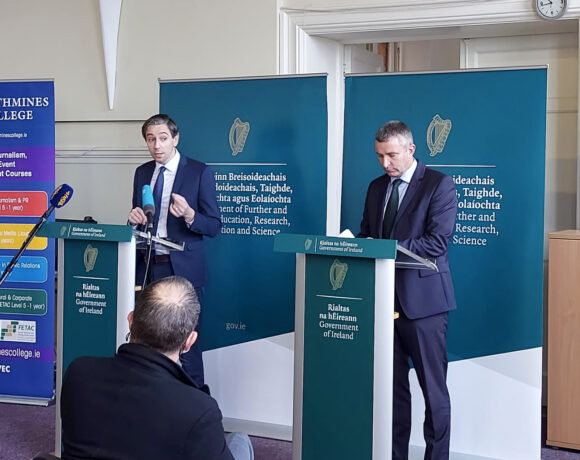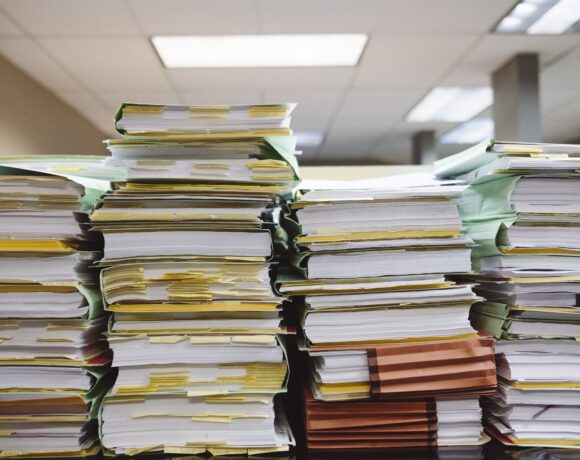Pictured above: Michael Guerin. Image courtesy of smartdocklands.ie
The head of Dublin’s Smart Docklands project discusses air-quality solutions and how technology is keeping Dublin’s river safe.
What is Smart Docklands?
Smart Docklands is Dublin’s Smart City Testbed. It was established in 2017 as a partnership between Dublin City Council and the CONNECT Research Centre at Trinity College Dublin. The objective is to provide a platform for innovators and entrepreneurs to test cutting-edge solutions to local challenges.
It is the first of Smart Dublin’s ‘Smart District’ programme which now includes five Smart Districts across the Dublin Region. We use the Quadruple helix model of city, industry, academia and citizen as the four key stakeholder groups in the district.
To-date we have had over 50 pilot projects ranging from mobility to environmental sensing to telecoms. Many of these have informed corporate decisions from the city including developing innovative procurement methodology and the recent establishment of a Telecoms Unit within Dublin City Council.
What is the main purpose of your role within Smart Docklands?
I have led the Smart Docklands programme since its inception in 2017. We now have a team of four including myself. My role is to drive the operations and development of the testbed. To do this I focus on relationship building among the stakeholders, which is critical to fruitful partnerships.
The role is sometimes described as an “Honest Broker” and the activities we carry out are often referred to as ‘boundary spanning’. This includes local businesses, local communities, universities and research bodies, start-ups, state agencies among many others.
We know that we will not work out all the answers to city challenges on our own, but if we collaborate and work together we can achieve great things. My role is to encourage and enhance our collaboration.
What have been Smart Docklands’ biggest achievements to date?
We have received several awards which are a good indicator of our achievements. These include Winner at the World Small Cell Awards 2019, a shortlisting at the World Smart City Awards 2019, and listed as No.1 for Strategy in the Smart Locations of the Future Awards run by Financial Times fDi Intelligence in 19/20.
However, the biggest achievement is without doubt the replicability of Smart Docklands as a model. We have used this model across five districts in Dublin and have helped other cities such as London who are keen to replicate the model.
I think this is largely due to the simple and agile approach we have taken, which is focused on collaboration. At the very beginning of the Smart Docklands programme we acknowledged we could not achieve a ‘smart’ district by going alone, or even with a small number of partners. Since then we have worked with over 200 partners and have an open door policy for researchers and innovators who want to address the challenges set out by our stakeholder groups.
Can you elaborate on the organisations you serve as an ’honest broker’ for and tell us why Smart Docklands’ role is so important?
Smart city organisations are horizontal in their nature, we cut across the many silos within the city council and also across many external verticals such as telecoms and transport. In doing so, it is important we remain as balanced and fair as possible brokering honest and open conversations.
This has manifested itself in many diverse ways, such as working with a local citizen-led environmental group after we became aware of air quality concerns in a part of the city. Through our network of partners we are able to introduce this group to a research body focused on air quality sensing. The academics were looking for citizens with air quality concerns; together they were able to deploy a number of sensors and measure the air quality over time to inform their next steps.
Similarly, our community engagement workshops flagged concerns among residents about the theft of life-saving ring buoys along the river. We studied the problem and found that over 500 ring buoys were taken or stolen each year in Dublin at a financial cost of €20,000 and an even greater cost with the potential loss of life. Having completed a market analysis, and with the extensive IoT knowledge gained from research we have carried out with the CONNECT Centre, we realised there was an opportunity to develop a solution to this challenge.
We initially secured funding and support from the European Assistance For Innovative Procurement (EAFIP). Through this we developed a method of procurement which enabled four companies to receive funding to trial their solution for 12 months in the city, and then if successful, each could join a framework for almost any local authority to buy the solution without writing their own tender. We also secured €40k funding from the Irish Government, and the four Dublin Local Authorities to support the trials of four solutions.
This gives a glimpse of the diversity of scenarios we encounter, while also getting a flavour of the role we play. In essence, we are a catalyst for enhanced collaboration among the appropriate entities to tackle a city challenge.
Can you explain the community engagement work Smart Docklands has been doing?
Community engagement is a fundamental component of the Smart Docklands programme. We do not deploy tech for tech’s sake: we run community workshops to identify city challenges and this ensures that there is a requirement for a solution before it is deployed. This may seem like a simple approach, but there are many examples of deployments in cities that did not address a real challenge.
We identified four main stakeholder groups in Dublin Docklands: Infrastructure, Tourism & Hospitality, Citizens and Property. We felt these groups would give us a good sample size for those who live and work in Dublin Docklands. To date we have run over 20 workshops with over 300 attendees. The two-hour workshops consist of a very simple structure: after a 15 minute introduction to Smart Docklands, participants focus on discussing the challenges they face locally. We have amassed over 350 challenges to date.
To manage expectations, it is made clear we will not solve all of these problems, however, it is important we hear about a wide range of problems and not only those that are immediately related to tech solutions. It needs to remain much more open than this.
The outputs at times are quite specific, such as the ringbuoy example. On other occasions we look at emerging themes. Safer cycling and mobility is our most frequently discussed challenge, with over 20 percent of named challenges fitting this category. To address this we have run two cycle tech challenges, and have worked with seven startups who have created solutions such as the See.Sense smart bike light or the recently launched Dublin Cycling Buddy.
 Forty four per cent of Ireland’s urban population lives in Dublin.
Forty four per cent of Ireland’s urban population lives in Dublin.
What does the term ’smart city’ mean to you?
When I started this job, I used to point out that smart cities are not about drones delivering pizzas as I felt this was a common misconception and a solution such as this was many years away. However, I have been proven wrong recently with Irish company Manna Aero now delivers food via drones in Ireland! There is a useful lesson in this: the pace of technological change is not only rapid – it is sometimes unpredictable.
Ultimately, for me, a smart city is about data-driven decisions. That does not mean more sensors and cameras; while this data can be important, the data collected during our community workshops on city challenges is equally important. We should respect and value different sources of data.
When we collect data, hard or soft, it gives us an informed baseline for discussion and debate and an opportunity to make better decisions. In the example of Smart Docklands, we collect ‘soft’ data in our engagement workshops which outline the challenges. We then often work with researchers or innovators to collect ‘hard’ data to validate if the challenge exists such as air quality concerns or on-street flooding. This data, both hard and soft can then be used by the city to inform decisions going forward. With advances in technology we are now able to do this in a relatively cheap and easy way, which offers the citizen more input to the city. In turn, it provides the city with the data required to make decisions. That’s a smart city.
What is your number one priority right now?
I have two… I am currently assisting the Dublin Regional Homeless Executive with deployment of a piece of software to replace a very manual process with a live system which is used in the service provided to thousands of homeless people in Dublin.
I am also Chair of the Telecom Infra Project (TIP) solution group: Connected City Infrastructure. Having led the deployment of Ireland’s first 5G small cell network in Smart Docklands with Dense Air, and recently published a discussion paper on Ireland’s road to 5G, we have taken the learnings from both of these projects and partnered with TIP to look at the utilisation of city infrastructure when deploying 5G and telecoms equipment.
The expected outcome for the TIP project is a scalable and transferable solution which will incorporate new commercial and operating models for cities. These will be made available for any city to avail of.
What do you see as your biggest achievement since you started the role?
It would have to be the success of the Districts model created in Smart Docklands. Seeing the growth of five new districts in Dublin is very satisfying and the potential for replication internationally is exciting.
We are strong supporters of knowledge sharing. This includes across city silos, industry verticals and from city to city. When we started with the Smart Dublin and Smart Docklands programmes we learned a huge amount from cities such as Eindhoven and Bristol, we continue to learn from many more. If our experience and learning can assist another city, that is a great achievement.
We have also role modelled a dynamic engagement between academia and the local authority. CONNECT is the Science Foundation Ireland research centre for future networks and communications and its ENABLE research programme, which focuses on smart communities, is a natural fit for this work.
What is the best part of the job?
The people. In Smart Dublin we have an incredibly strong and agile team. All of the examples I have outlined so far have been true team efforts and would not be possible with the diverse abilities across our team.
Also, pre-Covid-19 there were also many more opportunities to meet people from all industries and backgrounds. I really enjoy speaking at events and hearing different perspectives from different cities and countries, especially when there is a healthy debate.
What is your biggest challenge?
Change in local government can be slow. The challenge in public sector innovation is often not the technology or even the procurement, although that can be a challenge, rather it is the speed of the process. Before working in Smart Dublin I was National Operations Manager for Startup Ireland. I worked closely with many innovation driven enterprises, both start-ups and scaleups. It was in their nature to be agile and have an appetite for risk. These are not attributes typically associated with local government.
Although that is changing, we are some time away from Design Thinking or Lean Startup being the preferred methodology for problem solving in local government. It is used in innovation teams, but often they are a bolt-on to the ‘business as usual’ approach.
We often hear of a smart city programme associated with ‘death by pilots’. This is a real challenge and taking a pilot to scale or embedding in the city is difficult. It requires a particular skillset and human-orientated approach to bring a pilot through resistance to fruition. When a city innovation team breaks down the barrier of bringing a pilot to scale, they are overcoming one of the greatest challenges.
If you weren’t doing this job, what would you be doing?
I would probably have launched a start-up. Just before taking this job back in 2017 I was putting together the concept of an app that was cashless payments on the streets. The concept was one app which you could give donations directly to buskers, street performers and homeless people. The app would use blockchain to ensure the donations went directly to that person and aimed to avoid the challenge of an app just for one group of recipients. I had dreams of adding a live streaming feature for the buskers so users could listen to live music from cities all around the world in one app. I would still love to do something similar.
If you could make one change to Dublin tomorrow and money was no object, what would you do?
If money was no object I would of course like to see an end to homelessness, however while homelessness often becomes visible on the streets, it’s a result of larger systemic problems.
I would love to see underground transport in Dublin. It is an old European city not built to cater for this amount of people. The amount of space above ground is limited and with each generation we attempt to replace one mode of transport with a better one. We had trams in the early 20th century, then we went to cars, then buses, now we are back to trams and looking for more cyclists and maybe even scooters.
Space is a constraint. While an underground rail network like London or NYC is a huge undertaking, and very costly, it’s an investment in the future. Just imagine all of the things you could do with pedestrianised streets if public transport ran below ground!
Source: www.smartcitiesworld.net













